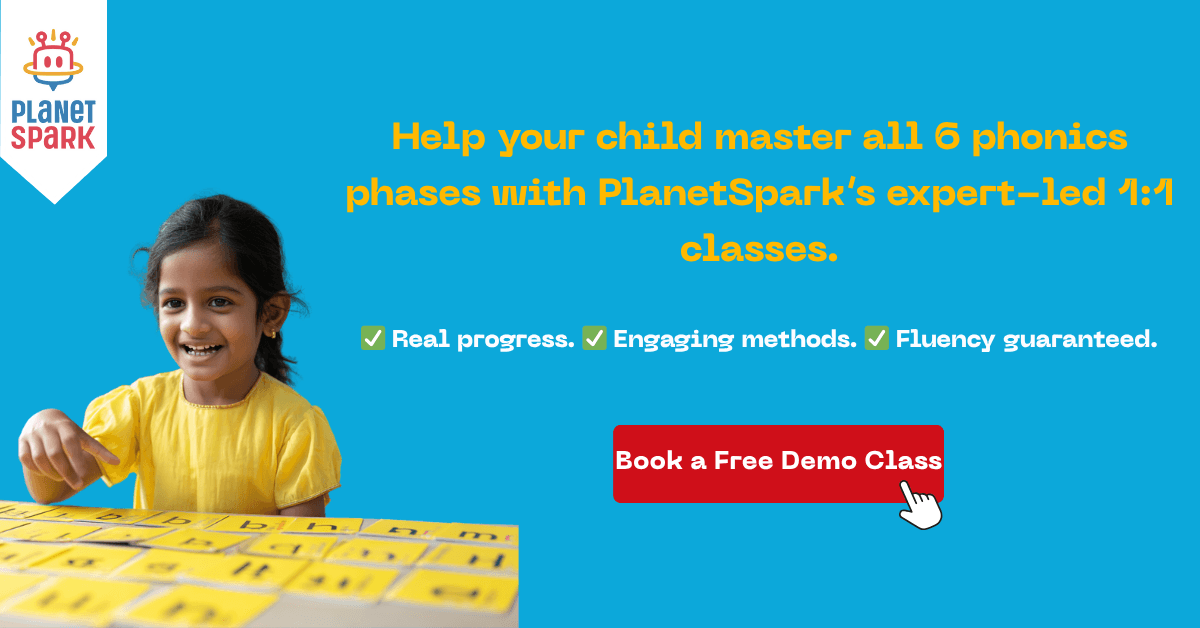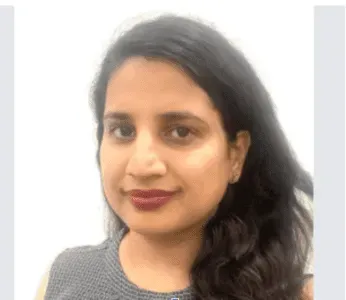Step-by-Step 6 Types of Phonics Phases for Early Readers

What Is Phonics?
Phonics is a teaching method that helps children learn how to read and write by connecting sounds with letters or groups of letters. This essential literacy skill forms the foundation of reading fluency and spelling accuracy in the early school years.
Phonics for kids involves teaching them to recognise, blend, and segment letter sounds to build reading and writing skills. It is introduced in stages, starting from listening skills to advanced spelling and grammar rules by Grade 2.
Phonics helps children decode unfamiliar words by sounding them out and boosts confidence in reading independently. Through structured stages called phonics phases, children gradually become fluent readers and accurate spellers.
Why Phonics Matters for Kids
Builds reading fluency from a young age
Improves pronunciation and vocabulary
Develops writing and spelling accuracy
Helps kids become confident speakers and readers
Supports spoken English development

Phonics Phases Explained
Phonics is taught in six distinct phases, typically from preschool to Grade 2. Each phase builds upon the previous one, and children progress at their own pace depending on their learning style and exposure.
Phase 1: Listening and Sound Awareness
This phase lays the foundation by helping kids develop listening skills and an awareness of environmental sounds. It usually begins before formal schooling starts.
Focus areas in Phase 1:
Environmental sounds (e.g., birds chirping, traffic)
Instrumental sounds (musical instruments)
Body percussion (clapping, tapping)
Voice sounds (intonation, pitch)
Rhythm and rhyme
Alliteration
Oral blending and segmenting
Goal: Help children identify, mimic, and differentiate between sounds around them.
Phase 2: Learning Letter Sounds
In this phase, kids start learning the 19 most common phonemes the smallest units of sound. They also begin to read and write VC (vowel-consonant) and CVC (consonant-vowel-consonant) words.
Common phonemes taught: /s/, /a/, /t/, /p/, /i/, /n/, /m/, /d/, etc.
Outcomes:
Begin sound-letter recognition
Read simple words like sat, pin, map
Start writing using basic sounds
Phase 3: Digraphs and Tricky Words
In this 12-week phase, children learn 25 more phonemes, including digraphs, two letters that make one sound.
Examples:
Digraphs: /ch/, /sh/, /th/, /ee/, /ow/, /ar/
Tricky words: he, she, was, you, they, my
What they learn:
Blend and segment CVC words
Recognise tricky words that cannot be sounded out
Associate letter names with sounds
Phase 4: Blending and Sentence Building
Now children consolidate everything they’ve learned. They no longer learn new sounds but practise combining them to read longer words and build sentences.
Activities in Phase 4:
Read and write CVCC words: lamp, nest, milk
Introduced to high-frequency words
Start writing full sentences
Continued practice with tricky words
Goal: Children should start recognising words without having to sound them out.
Phase 5: Alternate Spellings and Pronunciations
Kids learn that many sounds can be written in different ways. They are introduced to alternative spellings for the same sounds and begin spelling unfamiliar words more independently.
Key learnings:
Graphemes: Different letter combinations for the same sound (e.g., igh can be ie, y, i-e)
Alternative pronunciations: read (present vs. past)
Learn more tricky words and correct letter formation
Duration: Takes the full Grade 1 year for mastery.
Phase 6: Fluent Reading and Spelling Rules
By Phase 6, the focus shifts from learning how to read to becoming fluent readers and confident writers.
Skills developed in this phase:
Spelling rules (prefixes, suffixes, tenses)
Punctuation and proofreading
Use of apostrophes and dictionaries
Silent reading and comprehension
Goal: Build automaticity, children can now read hundreds of words without needing to decode each one.

Turn Sounds into Strong Communication
PlanetSpark goes beyond phonics, we help your child build vocabulary, pronunciation, and public speaking skills too. Book A Free Trial Class!
Summary Table: Phonics Phases at a Glance
| Phase | Focus Area | Expected Age | Key Outcome |
|---|---|---|---|
| Phase 1 | Listening & Sound Awareness | 3–4 years (Preschool) | Recognise and reproduce everyday sounds |
| Phase 2 | Basic Letter Sounds (Phonemes) | 4–5 years (Kindergarten) | Read/write simple VC & CVC words |
| Phase 3 | Digraphs & Tricky Words | 5 years | Read CVC + digraph words; tricky word memory |
| Phase 4 | Sentence Building & CVCC Words | 5–6 years | Form sentences; improved fluency |
| Phase 5 | Alternative Spellings & Graphemes | 6–7 years (Grade 1) | Handle spelling variations and long words |
| Phase 6 | Fluency & Grammar Rules | 7–8 years (Grade 2) | Fluent reading + spelling with rules |
Why Early Phonics Support Matters
Spoken English is a common challenge among young learners, especially when foundational skills like phonics are weak. Giving your child a strong start with structured phonics lessons is one of the best ways to ensure reading fluency and long-term language confidence.
PlanetSpark’s Phonics Classes: Structured, Engaging, and Effective
When it comes to building a strong foundation in reading and spoken English, PlanetSpark offers one of the most comprehensive phonics programs for kids in Grades 2 and 3. Designed by experts and delivered through 1:1 live classes, this course blends phonics mastery with engaging activities in reading, writing, and storytelling.
What Makes PlanetSpark’s Phonics Program Unique?
PlanetSpark doesn’t just teach sounds and letters, it helps your child become a confident reader and communicator through a multi-dimensional learning approach.
Here’s what your child will learn in PlanetSpark’s Phonics curriculum:
Phonic & Phonological Rules
Consonant trigraphs like tch, mph
Three-letter S-blends: sch, scr, shr, str, spl, spr
C and K rule: When to use ck after a vowel
Vowel combinations: au, aw, oi, oy
Inflectional endings: Adding -ing, -ed, -s, -er, -est
Reading Comprehension
Decodable texts for sentence-level fluency
Making text-to-self connections
Asking and answering “WH” questions
Fluency through rhymes and short paragraphs
Storytelling and Performance
Creative story maps and sequencing
Story retelling with rhythm and rhyme
Dramatic expression and oral delivery
Writing Skills
Narrative writing: Sequencing events logically
Character sketches: Describing traits and actions
Opinion writing: Sharing personal views
Creating alphabet, number, and shape poems
Exploring imagery and rhyming words in poetry
Program Highlights
165+ 1:1 interactive classes with expert trainers
Personalised learning plan based on your child’s reading level
Use of Spark Diary to track daily learning
Gamified quizzes and AI-based speech feedback (via SparkX)
Parent-teacher meetups and detailed progress reports
Why PlanetSpark Works
Most phonics programs stop at sound recognition. PlanetSpark goes further, blending phonics, comprehension, writing, and public speaking into one integrated program. It doesn’t just prepare kids to read, it prepares them to communicate with confidence.
Ready to level up your child’s phonics journey?
👉 Book a FREE demo with PlanetSpark now
FAQs on Phonics for Kids
Q1. At what age should a child start phonics?
Children can begin phonics activities from age 3–4, starting with listening skills and sound awareness.
Q2. How long does it take to complete all phonics phases?
Typically, from preschool to the end of Grade 2 (around 4 years), depending on the child’s pace.
Q3. Can I teach phonics at home?
Yes, but structured programs like PlanetSpark offer guided learning, which ensures faster and more accurate fluency development.
Q4. What’s the difference between phonics and spoken English?
Phonics focuses on decoding written language. Spoken English focuses on speaking fluently, confidently, and grammatically.
Personalized Communication Report
Record a video to get a AI generated personalized communication report for your child

Hi There, want to try these
tips for your child with
LIVE with our expert coach?
Let's check your child's
English fluency
